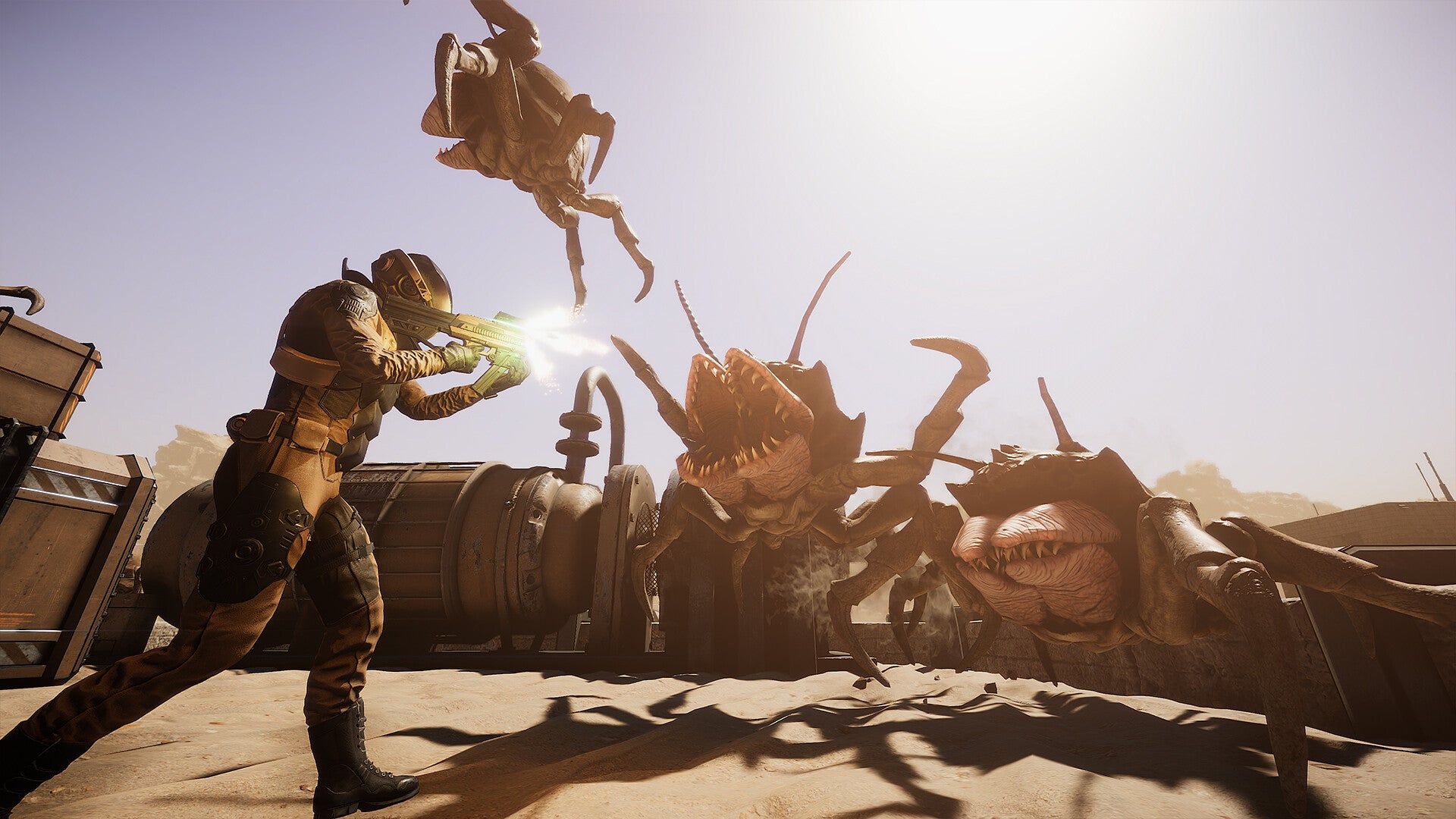Silica Preview: This RTS/FPS Hybrid Is the Best Kind of ‘Buggy’

Cruising the dunes of an alien world is probably one of those sci-fi concepts that’s going to stick with all of us forever. Silica, an upcoming real-time strategy and shooter hybrid published by Bohemia Interactive’s incubator division, brings a new angle on the genre by going for scale over anything else. Set in sprawling desert environments of 3 kilometers or more on a side, Silica is the story of two human factions competing for an exotic resource while a vicious hive of alien natives tries to eat them (and all their stuff).
I recently got a look at an in-progress build of Silica, and what I found was an interesting take on a genre that has been often attempted but rarely perfected. The three-way brawl in the multiplayer mode had a lot of potential, making me feel like someone dumped Command and Conquer units into a military sandbox… then wild-card threw some Starcraft Zerg in there for a big dose of chaos.
The two human factions are identical, for now, but focus on an escalating tree of ever-more-powerful units. Foot combat lets you use rifles, missiles, and the like, but the real fighting gets done in vehicles. In the early game your job was to scout enemy positions and do some minor skirmishing, but it was really all about protecting the massive, building-sized harvesters as they got your team’s economy up and running. Once those slower early minutes elapsed it was off to the races, with you able to quickly respawn and teleport your on-foot soldier to the front lines. That or have the commander pump out a vehicle to use, from buggies to wheeled gun platforms and hovering tanks, climaxing with extreme firepower like long-range missile units and the floating pyramid-sized Siege Tank with its massive plasma cannon.
Those big maps and a day-night cycle are really what give the matches a lot of their character. Meanwhile, the alien faction is much more a game of hide and seek. With the ability to scale any surface, aliens are far more mobile from the start than the humans. Their hives, however, were much more vulnerable, requiring stealthy expansion to not meet an early end; The scuttling little shrimps that gather alien resources are far easier to pick off with a rifle than the huge human harvester units. For all that the alien tech tree was also far easier to climb, and left alone the aliens can comparatively quickly field their massive, tank-like goliath bugs to pound human buildings into dust.
Those big maps and a day-night cycle are really what give the matches a lot of their character. Any start is slow simply because you’re presented with a huge field to explore to simply find the enemy, let alone disrupt them. Good scouting is vital to knowing when and where enemy attacks will come, as even the fastest units take a lot of time to get from one point to another. The time of day really ends up mattering, as while humans can use night vision it’s a far cry from the aliens’ almost crystal-clear ability to see what’s going on in the dark.
The version of Silica that I played was definitely rough, but that’s not what I’m concerned with in an in-progress game. My biggest worry is whether or not the urge to play more is stronger than any frustration from janky or unfinished bits, and here it definitely was. But the persistent problem of balance between two very different game modes is definitely present. AI-controlled enemies are notorious in this genre for either perfect accuracy or woeful uselessness. Playing on the ground as a soldier didn’t feel impactful until you got in a vehicle—and coordinating with others was completely vital to getting things done. There just wasn’t much a single soldier can do besides scout out enemy positions in a buggy; Assault rifle damage feels totally impotent against big bugs or enemy vehicles, but choosing a missile launcher or sniper rifle means your only weapon is extremely specialized.
Hopefully future improvements and new weapons can fix that. Loadouts like grenades, mines, and explosives would do a lot for infantry play across the classes. The developer Dram, who I must note here is a single person named Martin Melichárek, has overflowing plans for Silica. Ground transports are on their way in the near future, as are more complex tech trees or upgrades. There are also air units in the works, which would fundamentally change how you can hide, scout, and fight on these huge maps. I’ll be watching Silica’s journey through early access with extreme interest.
Author: Ryan McCaffrey. [Source Link (*), IGN All]





